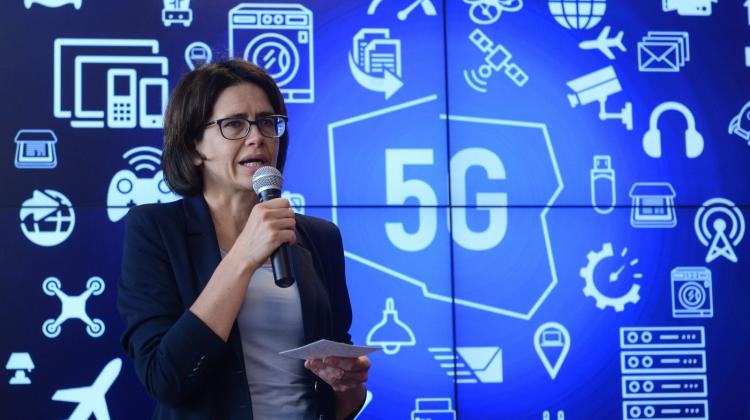There will be more 5G network base stations, but they will send signals with more precision
 Photo: Fotolia
Photo: Fotolia
The density of base stations in 5G network will be much higher than now. But the stations will be smaller and they will send a signal to the user with more precision than today - explains Dr. Jacek Wszołek from the Department of Telecommunications AGH-UST in an interview with PAP.
How does mobile telephony work? To put it simply, when you call someone, your mobile phone connects - by generating radio waves - to the nearest base station and sends encrypted information about the called recipient. The station forwards this information so that it ultimately reaches the base station near the recipient. And that base station - by sending a radio signal - connects to the recipient`s phone.
Such mobile telephony base stations are scattered throughout the country and the world. They divide the area into "cells" (hence the name "cellphone"), within which there is coverage and you can connect to the network. A base station usually covers three such "cells".
In Poland, the distances between base stations are now between 2 km (in cities) and over 20 km (in rural areas). Currently, next generations of the mobile network: 2G, 3G and 4G are in use in our country.
Typically, in a 4G network, approximately 1,000 active devices (ones that transmit data at a given moment) can be connected simultaneously to one "cell". It may seem a lot, but we live in a time when the Internet of Things is gaining popularity: not only to people are connected to the network, but also devices, bicycles, electric scooters, cars, CCTV cameras, even bulbs and toys. It is quite likely that in a while we will reach the technical limit of devices per "cell".
One answer to this challenge would be a 5G network. "It will allow to connect up to 1 million devices per square km" - says Dr. Jacek Wszołek from the Department of Telecommunications of the AGH University of Science and Technology in Kraków. And that limit, even with the more sophisticated Internet of Things solutions, should be sufficient for now.
How is the 5G network different from the current generations of mobile networks? The researcher points out that 5G networks will use more radio frequencies, in addition to those currently used by 2G, 3G and 4G networks. Now, for example, the range is from 800 MHz to a maximum of 5 GHz. And a 5G network is expected to support higher frequencies, up to around 52 GHz.
Dr Wszołek adds that in the new system, a single channel, in which it will be possible to send information, will be much wider (up to 400 MHz, compared to 20 MHz in 4G systems). And that means that the transmission speed will be much higher than now. Thanks to this, not only more devices will be able to connect to the network, but they will be able to send much larger amounts of data.
Higher frequency waves have slightly different properties than those with frequencies currently used in cellular networks. Namely, these waves are more suppressed and more easily dispersed in the media, through which they pass. The air, walls of buildings, the human body, even leaves on trees constitute more difficult obstacles for them than they do for lower frequency waves. Therefore, in order to avoid having to transmit a signal with enormous powers, the distances between base stations must be reduced.
"In 5G networks, the distances between base stations operating at high frequencies will not be a kilometre or 20 km - like between today`s 2G, 3G and 4G stations - but, for example, 200-500 m. The density of base stations will significantly increase" - the researcher says.
"People are sometimes afraid of it, because they imagine that if there are more stations, they will emit more electromagnetic radiation. But that does not have to be the case" - Dr. Wszołek emphasises. He notes that currently, when we put the phone to the ear, it must connect to a base station up to 20 km away. The phone muse emit a signal with sufficient power for the base station to receive it.
"And if we have a base station only 300 m away, the signal can be transmitted with less power" - he adds. He explains that it will work both ways - the base station will also emit signals with less power, because the radio wave will not have to travel 20 km, but over much, much smaller distances.
It has been 25 years since we started using mobile phones, the AGH scientist reminds, and yet there is still no reliable research that clearly proves that radiation - be it from mobile phones or base stations - is harmful. But, he adds, there are no reliable studies showing that this radiation is harmless. In the case of the frequencies in 5G networks, there is no scientific evidence confirming or refuting the harmfulness either, but 5G network is still a technological novelty, so large-scale research has not yet begun.
Dr. Wszołek describes that currently used antennas on base stations are boxes with a height of approx. 1.5 m and width and depth of 20-40 cm. To more easily form a "cell" and achieve the "glow" effect of the antenna from above, these devices are placed on tops of buildings or high towers, making it seem that the device emitting waves is quite large.
In a 5G network, the base stations will be smaller, because they will be closer to each other, and they will not have to emit such a strong omnidirectional signal as before. In addition, beamforming technology will allow to send the radio signal precisely towards the user, and thus it will not affect all users in the cell, like before.
"Such a base station will be the size of a shoe box, plus an antenna" - says Dr. Wszołek. He adds that such antennas will also be smaller than today. "The higher the wave frequency, the smaller the antenna can be" - he explains.
The researcher from AGH-UST explains that 5G stations operating at high frequencies will be placed either in the middle of buildings or at the street level - for example on a building wall or a low mast, much less often on a high mast.
PAP - Science in Poland, Ludwika Tomala
lt/ agt/ kap/
tr. RL
Przed dodaniem komentarza prosimy o zapoznanie z Regulaminem forum serwisu Nauka w Polsce.

















